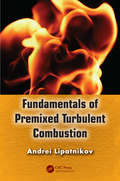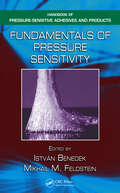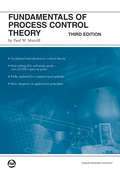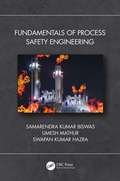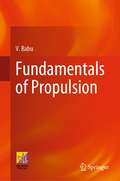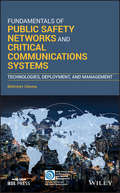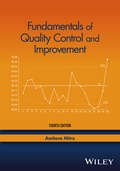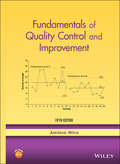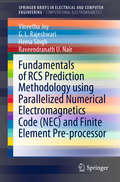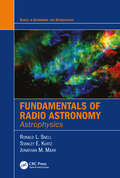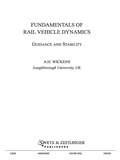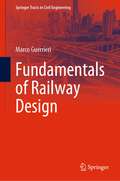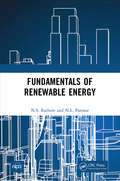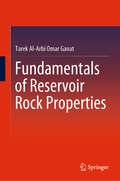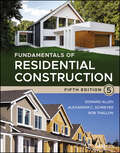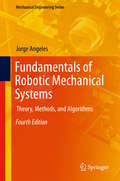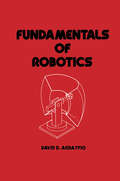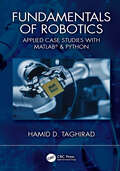- Table View
- List View
Fundamentals of Premixed Turbulent Combustion
by Andrei LipatnikovLean burning of premixed gases is considered to be a promising combustion technology for future clean and highly efficient gas turbine combustors. Yet researchers face several challenges in dealing with premixed turbulent combustion, from its nonlinear multiscale nature and the impact of local phenomena to the multitude of competing models. Filling
Fundamentals of Pressure Sensitivity (Handbook of Pressure-Sensitive Adhesives and Products)
by Mikhail M. Feldstein István BenedekDiscussing the definition of pressure sensitivity and characterization of pressure-sensitive behavior, Volume 1 of the Handbook of Pressure-Sensitive Adhesives and Products presents the underlying theory beh
Fundamentals of Process Control Theory, 3rd Edition
by P. W. MurrillThis expanded and updated second edition includes drum level compensation equations, additional P&ID drawings and examples of permissive startup and tripping logic for gas, oil, and coal fired boilers. It also covers different control schemes for furnace draft control. NFPA 85 Code 2007 control system requirements are included, with illustrated examples of coal fired boilers, as well as information on the latest ISA-77 series of standards.
Fundamentals of Process Safety Engineering
by Samarendra Kumar Biswas Umesh Mathur Swapan Kumar HazraThis textbook covers the essential aspects of process safety engineering in a practical and comprehensive manner. It provides readers with an understanding of process safety hazards in the refining and petrochemical industries and how to manage them in a reliable and professional manner. It covers the most important concepts: static electricity, intensity of thermal radiation, thermodynamics of fluid phase equilibria, boiling liquid expanding vapor explosion (BLEVE), emission source models, hazard identification methods, risk control and methods for achieving manufacturing excellence while also focusing on safety. Extensive case studies are included. Aimed at senior undergraduate and graduate chemical engineering students and practicing engineers, this book covers process safety principles and engineering practice authoritatively, with comprehensive examples: • Fundamentals, methods, and procedures for the industrial practice of process safety engineering.• The thermodynamic fundamentals and computational methods for release rates from ruptures in pipelines, vessels, and relief valves.• Fundamentals of static electricity hazards and their mitigation.• Quantitative assessment of fires and explosions.• Principles of dispersion calculations for toxic or flammable gases and vapors.• Methods of qualitative and quantitative risk assessment and control.
Fundamentals of Propulsion
by V. BabuThis highly informative book offers a comprehensive overview of the fundamentals of propulsion. The book focuses on foundational topics in propulsion, namely gas dynamics, turbomachinery, and combustion to more complex subjects such as practical design aspects of aircraft engines and thermodynamic aspects and analysis. It also includes pedagogical aspects such as end-of-chapter problems and worked examples to augment learning and self-testing. This book is a useful reference for students in the area of mechanical and aerospace engineering. Also, scientists and engineers working in the areas of aerospace propulsion and gas dynamics find this book a valuable addition.^
Fundamentals of Public Safety Networks and Critical Communications Systems: Technologies, Deployment, and Management (IEEE Press Series on Networks and Service Management)
by Mehmet UlemaA timely overview of a complete spectrum of technologies specifically designed for public safety communications as well as their deployment as management In our increasingly disaster-prone world, the need to upgrade and better coordinate our public safety networks combined with successful communications is more critical than ever. Fundamentals of Public Safety Networks and Critical Communications Systems fills a gap in the literature by providing a book that reviews a comprehensive set of technologies, from most popular to the most advanced communications technologies that can be applied to public safety networks and mission-critical communications systems. The book explores the technical and economic feasibility, design, application, and sustainable operation management of these vital networks and systems. Written by a noted expert in the field, the book provides extensive coverage of systems, services, end-user devices, and applications of public-safety services and technologies. The author explores the potential for advanced public safety systems, and this comprehensive text covers all aspects of the public safety and critical communications network field. This important book: Provides an introduction to and discussion of the common characteristics of our critical communications systems Presents a review of narrowband technologies such as Project 25, TETRA, and DMR as well as the broadband technologies such as the LTE technology Focuses on the emerging technologies that can be adopted to improve our vital communications systems Discusses deployment of such technologies, including economics and finance, planning and project management Provides, in detail, the issues and solutions related to the management of such communications networks Offers a complete list of standards documents Written for professionals in the industry, academics, and government and regulatory agencies, Fundamentals of Public Safety Networks and Critical Communications Systems offers a review of the most significant safety technologies, explores the application for advanced technologies, and examines the most current research.
Fundamentals of Public Utilities Management
by Frank R. SpellmanFundamentals of Public Utilities Management provides practical information for constructing a roadmap for successful compliance with new and ever-changing regulatory frameworks, upgrading and maintenance, and general management of utilities operations. It describes current challenges faced by utility managers and offers best practices. In an effort to maximize the usefulness of the material for a broad audience, the text is written in a straightforward, user-friendly, conversational style for students and practicing professionals alike. Features: Presents numerous illustrative examples and case studies throughout Examines environmental compliance and how to best work with continually changing regulations Frames the discussions in a context of energy conservation and ongoing sustainability efforts Fundamentals of Public Utilities Management is designed to provide insight and valuable information to public utility sector managers and prospective managers in water operations (drinking water, wastewater, storm water), and to serve the needs of students, teachers, consulting engineers, and technical personnel in city, state, and federal public sectors.
Fundamentals of Quality Control and Improvement
by Amitava MitraA statistical approach to the principles of quality control and managementIncorporating modern ideas, methods, and philosophies of quality management, Fundamentals of Quality Control and Improvement, Third Edition presents a quantitative approach to management-oriented techniques and enforces the integration of statistical concepts into quality assurance methods. Utilizing a sound theoretical foundation and illustrating procedural techniques through real-world examples, this timely new edition bridges the gap between statistical quality control and quality management.The book promotes a unique "do it right the first time" approach and focuses on the use of experimental design concepts as well as the Taguchi method for creating product/process designs that successfully incorporate customer needs, improve lead time, and reduce costs. Further management-oriented topics of discussion include total quality management; quality function deployment; activity-basedcosting; balanced scorecard; benchmarking; failure mode and effects criticality analysis; quality auditing; vendor selection and certification; and the Six Sigma quality philosophy.The Third Edition also features:Presentation of acceptance sampling and reliability principlesCoverage of ISO 9000 standardsProfiles of past Malcolm Baldrige National Quality Award winners, which illustrate examples of best business practicesStrong emphasis on process control and identification of remedial actionsIntegration of service sector examplesThe implementation of MINITAB software in applications found throughout the book as well as in the additional data sets that are available via the related Web siteNew and revised exercises at the end of most chaptersComplete with discussion questions and a summary of key terms in each chapter, Fundamentals of Quality Control and Improvement, Third Edition is an ideal book for courses in management, technology, and engineering at the undergraduate and graduate levels. It also serves as a valuable reference for practitioners and professionals who would like to extend their knowledge of the subject.
Fundamentals of Quality Control and Improvement
by Amitava MitraThe newest edition of an insightful and practical statistical approach to quality control and management In the newly revised and thoroughly updated Fifth Edition of Fundamentals of Quality Control and Improvement, accomplished academic, consultant, and author Dr. Amitava Mitra delivers a comprehensive and quantitative approach to quality management techniques. The book demonstrates how to integrate statistical concepts with quality assurance methods, incorporating modern ideas, strategies, and philosophies of quality management. You'll discover experimental design concepts and the use of the Taguchi method to incorporate customer needs, improve lead time, and reduce costs. The new edition also includes brand-new case studies at the end of several chapters, references to the statistical software Minitab 19, and chapter updates that add discussions of trending and exciting topics in quality control. The book includes access to supplementary material for instructors consisting of a new instructor's solutions manual and PowerPoint slides, as well as access to data sets for all readers. Readers will also benefit from the inclusion of: A thorough introduction to the evolution of quality and definitions of quality, quality control, quality assurance, quality circles, and quality improvement teams An exploration of customer needs and market share, as well as the benefits of quality control and the total quality system Practical discussions of quality and reliability, quality improvement, product and service costing, and quality costs A concise treatment of how to measure quality costs, the management of quality, and the interrelationship between quality and productivity Perfect for upper-level undergraduate and graduate students in quality control and improvement, the Fifth Edition of Fundamentals of Quality Control and Improvement will also earn a place in the libraries of business students and those undertaking training programs in Six Sigma.
Fundamentals of Queueing Theory (Wiley Series in Probability and Statistics)
by Donald Gross John F. Shortle Carl M. Harris James M. ThompsonThoroughly updated and expanded to reflect the latest developments in the field, Fundamentals of Queueing Theory, Fifth Edition presents the statistical principles and processes involved in the analysis of the probabilistic nature of queues. Rather than focus narrowly on a particular application area, the authors illustrate the theory in practice across a range of fields, from computer science and various engineering disciplines to business and operations research. Critically, the text also provides a numerical approach to understanding and making estimations with queueing theory and provides comprehensive coverage of both simple and advanced queueing models. As with all preceding editions, this latest update of the classic text features a unique blend of the theoretical and timely real-world applications. The introductory section has been reorganized with expanded coverage of qualitative/non-mathematical approaches to queueing theory, including a high-level description of queues in everyday life. New sections on non-stationary fluid queues, fairness in queueing, and Little’s Law have been added, as has expanded coverage of stochastic processes, including the Poisson process and Markov chains.
Fundamentals of RCS Prediction Methodology using Parallelized Numerical Electromagnetics Code (SpringerBriefs in Electrical and Computer Engineering)
by Hema Singh Raveendranath U. Nair Vineetha Joy G. L. RajeshwariThis book presents a novel methodology for the computation of RCS of metallic structures using a parallelized version of NEC in conjunction with a finite element preprocessor which has been strategically incorporated for simplifying geometry modelling catering to NEC guidelines. It includes a thorough overview of the theoretical background of NEC including all relevant aspects of formulation and modelling. The revised methodology including all the required steps and details is discussed elaborately along with case studies and validations. This book will serve as a valuable resource for students, researchers, scientists, and engineers working in the field of RCS predictions and measurements.
Fundamentals of RF and Microwave Techniques and Technologies
by Ulrich L. Rohde Matthias Rudolph Hans L. Hartnagel Rüdiger QuayThe increase of consumer, medical and sensors electronics using radio frequency (RF) and microwave (MW) circuits has implications on overall performances if design is not robust and optimized for a given applications. The current and later generation communication systems and Internet of Thing (IoT) demand for robust electronic circuits with optimized performance and functionality, but low cost, size, and power consumption. As a result, there is a need for a textbook that provides a comprehensive treatment of the subject. This book provides state-of-the-art coverage of RF and Microwave Techniques and Technologies, covers important topics: transmission-line theory, passive and semiconductor devices, active and passive microwave circuits and receiver systems, as well as antennas, noise and digital signal modulation schemes. With an emphasis on theory, design, and applications, this book is targeted to students, teachers, scientists, and practicing design engineers who are interested in broadening their knowledge of RF and microwave electronic circuit design. Readers will also benefit from a unique integration of theory and practice, provides the readers a solid understanding of the RF and microwave concepts, active and passive components, antenna, and modulation schemes. Readers will learn to solve common design problems ranging from selection of components, matching networks to biasing and stability, and digital modulation techniques. More importantly, it provides basic understanding in the analysis and design of RF and microwave circuits in a manner that is practiced in industry. This make sure that the know-how learned in this book can be effortlessly and straightway put into practice without any obstacles.
Fundamentals of Radiation Dosimetry (Series in Medical Physics and Biomedical Engineering #Vol. 15)
by J.R GreeningThis book reviews ionising radiation quantities and the relationships between them and discusses the principles underlying their measurement. The emphasis is on the determination of absorbed dose and related dosimetric quantities.
Fundamentals of Radio Astronomy: Astrophysics (Series in Astronomy and Astrophysics)
by Stanley Kurtz Ronald L. Snell Jonathan MarrAs demonstrated by five Nobel Prizes in physics, radio astronomy has contributed greatly to our understanding of the Universe. Courses covering this subject are, therefore, very important in the education of the next generation of scientists who will continue to explore the Cosmos. This textbook, the second of two volumes, presents an extensive introduction to the astrophysical processes that are studied in radio astronomy. Suitable for undergraduate courses on radio astronomy, it discusses the physical phenomena that give rise to radio emissions, presenting examples of astronomical objects, and illustrating how the relevant physical parameters of astronomical sources can be obtained from radio observations. Unlike other radio astronomy textbooks, this book provides students with an understanding of the background and the underlying principles, with derivations available for most of the equations used in the textbook. Features: Presents a clear and concise discussion of the important astronomical concepts and physical processes that give rise to both radio continuum and radio spectral line emission Discusses radio emissions from a variety of astronomical sources and shows how the observed emissions can be used to derive the physical properties of these sources Includes numerous examples using actual data from the literature
Fundamentals of Rail Vehicle Dynamics: Guidance And Stability
by Alan WickensFundamentals of Rail Vehicle Dynamics lays a foundation for the design of rail vehicles based on the mechanics of wheel-rail interaction as described by the equations of motion. The author advances simple models to elucidate particular challenges and demonstrate innovative systems while using analytical studies to examine novel design concepts. Rather than focusing on a "typical" set of parameters, the book discusses the issues associated with the complete range of parameters available, concentrating on the configuration and parametric design of the bogie in relation to steering, dynamic response, and stability. This is an excellent reference for designers and researchers involved vehicle development.
Fundamentals of Railway Design (Springer Tracts in Civil Engineering)
by Marco GuerrieriThis textbook examines key railway engineering topics useful for railway design and control. Conventional railways are considered together with high-speed railways, tramways, metros, maglev and hyperloop systems, people movers, monorails and rack railways. Every system of transport is described in its basic technical characteristics, especially in terms of transportation system capacity, alignment design criteria and construction costs. It is an introductory book to specific topics of the railway engineering field, and thus, the mathematical treatment is purposely brief and simplified. The book is an ideal learning resource for students of civil engineering, as well as a valuable reference for practicing engineers involved with railway designs.
Fundamentals of Reaction Flowmeters
by Horia Mihai MoțitThis book is the first one that presents both the new elaborated method of the flow measurement, named by the author the "Flow Measurement Based on Reaction Force", including its specific "reaction measurement system", which ensures its practical implementation, and the new basic types of flowmeters, configured according to it, named "reaction flowmeters". These achievements were the result of the first implementation, in the last two years, of the Unitary Synthesis and Design Method of Flowmeters (European Patent EN the 3364159, granted in 2020). Due to its universality and flexibility, the "Flow Measurement Based on Reaction Force" keeps the same configuration of the reaction measurement system for the design of any new basic types of reaction flowmeters. The book presents the reaction flowmeters by following the logical sequence of their structural (implicitly functioning) evolution, which rendered the logical systematic way followed for their configuration. The book details successively (main analytical, constructive, and functional features) the individual (single) reaction flowmeters, configured both without and with moving parts, respectively, the specific connections of two single reaction flowmeters, named "extended reaction flowmeters" and the bypass type reaction flowmeters. All of these flowmeters can be used for both liquids and gases. Presenting the practical results and using the knowledge of the unitary bases of the flowmeters, identified by the previous book, Unitary Analysis, Synthesis, and Classification of Flow Meters (2018), this new publication is written for all specialists in the field of flow measurement and instrumentation, and especially for flowmeters manufacturers and R&D specialists, in addition to the teaching staff and students at such specialized, technical, and high-level universities. The book is also an efficient tool for predictable design of new types of reaction flowmeters, by following the logical steps (questions) already taken in the configuration of the reaction flowmeters presented, and by diversifying with new answers given to them.
Fundamentals of Reliability Engineering: Applications in Multistage Interconnection Networks
by Indra GunawanThis book presents fundamentals of reliability engineering with its applications in evaluating reliability of multistage interconnection networks. In the first part of the book, it introduces the concept of reliability engineering, elements of probability theory, probability distributions, availability and data analysis. The second part of the book provides an overview of parallel/distributed computing, network design considerations, and more. The book covers a comprehensive reliability engineering methods and its practical aspects in the interconnection network systems. Students, engineers, researchers, managers will find this book as a valuable reference source.
Fundamentals of Renewable Energy
by N.S. Rathore N.L. PanwarThis book is to provide in-depth information on fundamentals of different renewable energy resources. The primary emphasis is on fundamentals of thermodynamics and heat transfer aspects of renewable energy gadgets and their actual applications. Various renewable energy systems are described and their fundamental analyses are described.Note: T&F does not sell or distribute the hardback in India, Pakistan, Nepal, Bhutan, Bangladesh and Sri Lanka. This title is co-published with NIPA.
Fundamentals of Reservoir Rock Properties
by Tarek Al-Arbi GanatThis book explains the basic technologies, concepts, approaches, and terms used in relation to reservoir rocks. Accessible to engineers in varying roles, it provides the tools necessary for building reservoir characterization and simulation models that improve resource definition and recovery, even in complex depositional environments.The book is enriched with numerous examples from a wide variety of applications, to help readers understand the topics. It also describes in detail the key relationships between the different rock properties and their variables. As such, it is of interest to researchers, engineers, lab technicians, and postgraduate students in the field of petroleum engineering.
Fundamentals of Residential Construction
by Edward Allen Rob Thallon Alexander C. SchreyerFUNDAMENTALS OF RESIDENTIAL CONSTRUCTION THE NEW EDITION OF THE DEFINITIVE GUIDE TO PROFESSIONAL HOME CONSTRUCTION, FULLY UPDATED AND REVISED Fundamentals of Residential Construction provides clear, accurate, and accessible guidance to every step of single family and multifamily home construction, covering site preparation, project delivery methods, scheduling, foundations, framing, roofing, finishes, heating and cooling, plumbing and electrical, as well as emerging techniques such as prefabricated construction. Illustrated with more than 1,250 high-quality drawings, photographs, and photorealistic renderings throughout, this thorough textbook addresses all major construction systems: light wood frame, heavy timber, masonry, light gauge steel, steel frame, reinforced concrete construction, and outdoor structures. The fifth edition is thoroughly revised to reflect the industry’s latest methods, materials, technologies, and green building approaches, offering the most up-to-date explanations of today’s residential construction systems and current building codes, including the International Residential Code (IRC) and energy codes. This edition features entirely new materials sections on metals, plastics, and composite construction as well as expanded and updated content on ventilation, air-sealing, decks, and outdoor structures. Provides a solid foundation in residential construction methods, tools, and processes Discusses the latest codes, costs, trends, and best practices in design and construction Offers timely coverage of sustainable building, energy efficiency, multifamily construction, prefabricated building components, CAD/BIM planning tools, and carbon-conscious construction Includes access to a newly updated companion website with an instructor’s manual, chapter exercises, hands-on 3D interactive activities, and other supplementary resources Fundamentals of Residential Construction, Fifth Edition, remains essential reading for anyone looking to successfully complete a residential project. It is a perfect textbook for students in architecture, construction science, construction management, and building technology, and is a valuable reference for professional builders, construction managers, and designers.
Fundamentals of Risk Analysis and Risk Management
by Vlasta MolakThis book bridges the gap between the many different disciplines used in applications of risk analysis to real world problems. Contributed by some of the world's leading experts, it creates a common information base and language for all risk analysis practitioners, risk managers, and decision makers.Valuable as both a reference for practitioners and a comprehensive textbook for students, Fundamentals of Risk Analysis and Risk Management is a unique contribution to the field. Its broad coverage ranges from basic theory of risk analysis to practical applications, risk perception, legal and political issues, and risk management.
Fundamentals of Robotic Mechanical Systems
by Jorge AngelesThe 4th edition includes updated and additional examples and exercises on the core fundamental concepts of mechanics, robots, and kinematics of serial robots. New images of CAD models and physical robots help to motivate concepts being introduced. Each chapter of the book can be read independently of others as it addresses a seperate issue in robotics.
Fundamentals of Robotics
by David ArdayfioFundamentals of Robotics presents the basic concepts of robots to engineering and technology students and to practicing engineers who want to grasp the fundamentals in the growing field of robotics.
Fundamentals of Robotics: Applied Case Studies with MATLAB® & Python
by Hamid D. TaghiradIn an era where robotics is reshaping industries and redefining possibilities, "Fundamentals of Robotics: Applied Case Studies with MATLAB® & Python" emerges as an essential guide for both aspiring engineers and seasoned professionals. This comprehensive book bridges the gap between theoretical knowledge and practical application, driving advancements in robotics technology that mimic the complexity and grace of biological creatures.Explore the intricate world of serial robots, from their kinematic and dynamic foundations to advanced control systems. Discover how the precise movements of a magician's fingers or the poised posture of a king cobra inspire the mathematical principles that govern robotic motion. The book delves into the Denavit-Hartenberg method, screw theory, and the Jacobian matrix, providing a thorough understanding of robot design and analysis.Unique to this text is the integration of MATLAB® and Python, offering readers practical experience through step-by-step solutions and ready-to-use code. Each chapter is enriched with real-world case studies, including the 6-DOF Stanford robot and the Fanuc S-900w, allowing readers to apply theoretical concepts to tangible problems. The inclusion of biological examples enhances the relevance and accessibility of complex topics, illustrating the natural elegance of robotics.Key Features: Includes a diverse range of examples and exercises with accompanying MATLAB® and Python codes. Contains over 30 case studies which allows the readers to gain a thorough understanding. Aids instruction in classrooms with inclusion of teaching slides and handouts. Combines diverse topics like kinematics, dynamics, and control within a single book. Ideal for senior undergraduate and graduate students, as well as industry professionals, this book covers a wide range of topics, including linear and nonlinear control methods, trajectory planning, and force control. The dynamic models and control strategies discussed are crucial for anyone involved in the design, operation, or study of industrial robots."Fundamentals of Robotics: Applied Case Studies with MATLAB® & Python" is more than a textbook; it is a vital resource that provides the knowledge and tools needed to succeed in the dynamic field of robotics. Join the journey towards mastering robotic technology and contribute to the future of intelligent machines.
